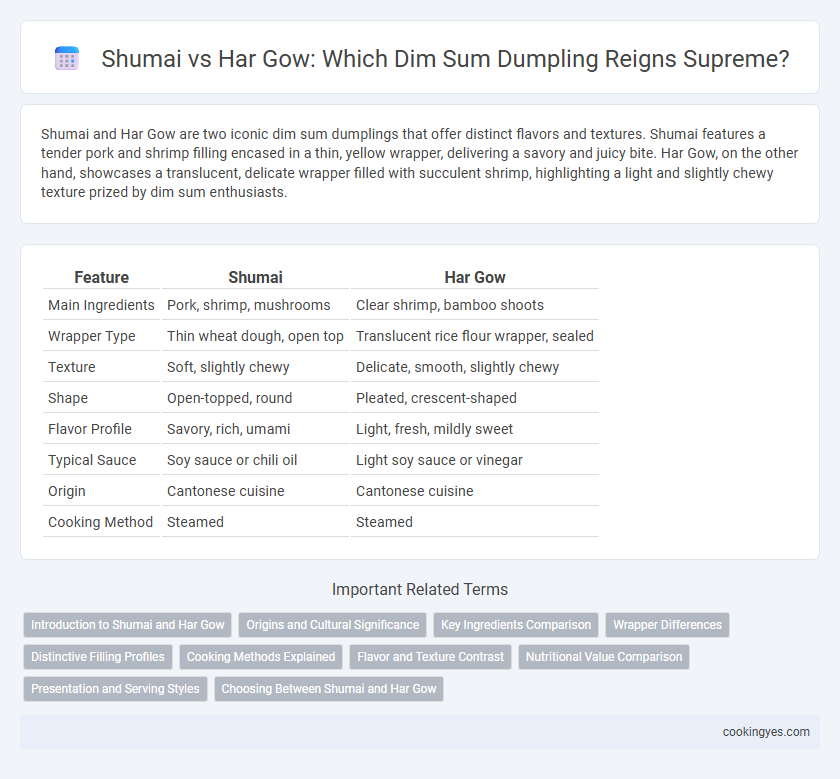Shumai and Har Gow are two iconic dim sum dumplings that offer distinct flavors and textures. Shumai features a tender pork and shrimp filling encased in a thin, yellow wrapper, delivering a savory and juicy bite. Har Gow, on the other hand, showcases a translucent, delicate wrapper filled with succulent shrimp, highlighting a light and slightly chewy texture prized by dim sum enthusiasts.
Table of Comparison
| Feature | Shumai | Har Gow |
|---|---|---|
| Main Ingredients | Pork, shrimp, mushrooms | Clear shrimp, bamboo shoots |
| Wrapper Type | Thin wheat dough, open top | Translucent rice flour wrapper, sealed |
| Texture | Soft, slightly chewy | Delicate, smooth, slightly chewy |
| Shape | Open-topped, round | Pleated, crescent-shaped |
| Flavor Profile | Savory, rich, umami | Light, fresh, mildly sweet |
| Typical Sauce | Soy sauce or chili oil | Light soy sauce or vinegar |
| Origin | Cantonese cuisine | Cantonese cuisine |
| Cooking Method | Steamed | Steamed |
Introduction to Shumai and Har Gow
Shumai and Har Gow are iconic dim sum dumplings that highlight distinct textures and flavors in Cantonese cuisine. Shumai features a thin, yellow wrapper filled with a savory mixture of pork, shrimp, and mushrooms, often topped with a small piece of roe or pea for garnish. Har Gow is renowned for its translucent, delicate rice flour wrapper encasing whole shrimp, offering a slightly chewy texture and subtle sweetness.
Origins and Cultural Significance
Shumai dumplings, originating from Cantonese cuisine, are traditionally filled with pork and shrimp and symbolize prosperity in Chinese culture, often served during festive occasions. Har Gow, with its translucent rice flour wrapper and shrimp filling, reflects the culinary artistry of Guangzhou's seafood heritage and emphasizes texture and freshness. Both dumplings hold significant cultural value within dim sum traditions, showcasing regional ingredients and culinary techniques distinctive to southern China.
Key Ingredients Comparison
Shumai features a filling primarily made from ground pork, shrimp, and mushrooms, often seasoned with soy sauce and sesame oil for a savory taste. Har Gow stands out with its translucent wrapper encapsulating a mixture of whole shrimp, bamboo shoots, and water chestnuts, offering a subtle crunch. The key ingredient difference lies in Shumai's pork-shrimp blend versus Har Gow's shrimp-centric filling with crunchy vegetables.
Wrapper Differences
Shumai dumplings feature a thin, yellow wheat-based wrapper that is typically pleated and open-topped, allowing the filling to be visible. Har Gow wrappers are made from a translucent rice flour dough that creates a smooth, slightly chewy texture, encasing the filling completely. The textural contrast between the firm wheat wrapper of shumai and the delicate, elastic rice wrapper of har gow highlights the diverse wrapper techniques in Cantonese dim sum.
Distinctive Filling Profiles
Shumai features a savory filling primarily composed of ground pork and shrimp, seasoned with soy sauce, ginger, and mushrooms, delivering a rich and umami-packed bite. Har Gow contrasts with its translucent wrapper encasing a delicate mixture of whole shrimp, bamboo shoots, and a touch of sesame oil, emphasizing a lighter, more textural profile. These distinctive filling profiles highlight Shumai's robust, meaty depth versus Har Gow's fresh, seafood-centric subtlety in dim sum cuisine.
Cooking Methods Explained
Shumai, typically steamed in bamboo baskets, have an open-top design that allows the filling, often pork and shrimp, to cook evenly through direct steam exposure. Har Gow, also steamed, use a translucent, slightly chewy rice flour wrapper that requires precise steaming to maintain their delicate texture while encasing shrimp filling. Proper steaming time and temperature are critical for both, ensuring Shumai remain juicy without drying out and Har Gow maintain their signature thin, smooth skin without becoming sticky.
Flavor and Texture Contrast
Shumai offers a rich, savory flavor with a slightly chewy, tender wrapper that complements its juicy pork and shrimp filling, delivering a satisfying umami experience. Har Gow features a delicate, translucent wrapper with a smooth, slightly elastic texture that encases a lightly seasoned shrimp filling, emphasizing freshness and subtle sweetness. The distinct contrast between Shumai's robust taste and Har Gow's refined delicacy highlights the diverse flavor and texture profiles integral to traditional dim sum.
Nutritional Value Comparison
Shumai and Har Gow, popular dim sum dumplings, differ significantly in nutritional value. Shumai typically contains pork and shrimp, offering higher protein content and moderate fat levels, while Har Gow, filled with primarily shrimp and wrapped in translucent rice flour skin, tends to be lower in fat and calories but also offers less protein. Choosing between them depends on dietary goals, with Shumai providing more energy and nutrients, whereas Har Gow is a lighter, lower-calorie option.
Presentation and Serving Styles
Shumai dumplings feature an open-top presentation showcasing a vibrant filling of pork and shrimp, often garnished with a pea or roe, highlighting their rustic, hearty appeal. Har Gow dumplings, on the other hand, boast a translucent, pleated wrapper that elegantly reveals the delicate shrimp interior, emphasizing a refined, delicate aesthetic. Both are traditionally served steamed in bamboo baskets, enhancing their authentic dim sum experience while allowing heat to circulate evenly.
Choosing Between Shumai and Har Gow
Choosing between Shumai and Har Gow for dim sum depends on texture and filling preferences. Shumai features a tender pork and shrimp filling with a slightly open top, offering savory and juicy flavors, while Har Gow showcases translucent wrappers encasing whole shrimp, delivering a delicate and slightly chewy bite. For those seeking a richer, meat-forward experience, Shumai is ideal; Har Gow suits diners favoring a lighter, seafood-centric option with a smooth texture.
Shumai vs Har Gow for dim sum dumplings Infographic

 cookingyes.com
cookingyes.com